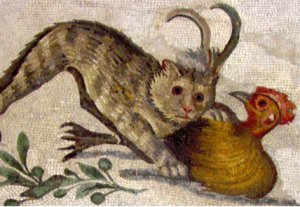Homemade food for cats - is it safe?

Before commercial cat food - Roman mosaic now in the Vatican Museum, Italy.
Although commercial pet food first became available in the 1890s, until the late 1950s most people made cat food at home. In fact during the war years 1939-1945 Britain and the US stopped making pet food as it was 'non-essential'. Then in the post-war years commercial pet food became almost universal, until the inevitable backlash today ('Why am I feeding corn to my cat?')
Home food advocates point out that for most of human history cats have had diets that were not covered by government regulation, or produced by techniques such as high-starch extrusion and high pressure sterilization (some cat foods are pressured to over 500 MPa, when 1 MPA = 145 pounds per square inch.) In other words, the modern dislike of highly-processed foods has spread to the cat-food industry, not least because cat food is generally much more processed than that consumed by humans.
Consequently feeding cats with food prepared at home has been gaining popularity. This has been helped by that other modern phenomenon, the Internet, where any search for 'home-made cat food' will give you hundreds of recipes. But how far can you trust what you read on the internet? Recent studies published in the Journal of the American Veterinary Medical Association say that most of those 'home-prepared' recipes are deficient in essential nutrients which cats require and what's more, some recipes contain ingredients which are potentially toxic to cats.
The group which did the studies was led by Sarah A. Wilson of the University of California. She and her colleagues assessed 114 recipes from online sources and reviewed books written by non-veterinarians as well as veterinarians.
They found that 40% of the recipes they evaluated provided no feeding instructions apart from those of the 'give it to your cat' variety. In the remaining recipes, the instructions lacked detail and were generally vague. The group then went on to evaluate the nutritional content of the recipes they had found. Only 94 of the 114 recipes provided enough information for a proper nutritional evaluation. None of the recipes analysed provided all the essential nutrients to meet the National Research Council's recommended allowances for adult cats, regardless of whether they were written by veterinarians or authors of unknown background.
Most recipes were deficient in at least three essential nutrients with some lacking as many as nineteen. Furthermore, when these nutrients were present, there was often not an adequate dose in the food. The nutrients most lacking were: choline, iron, zinc, thiamin, vitamin E and manganese. Understandably, most people preparing home recipes for their cats had no way to check whether they had included these ingredients, let alone whether they had included enough (but not too much) of each.
The cautionary tale went further with researchers pointing out that some recipes included ingredients that are potentially toxic to cats, including garlic, garlic powder, onions and leeks. There was also a concern about bones, in particular chicken bones which are very popular in homemade cat foods. Most recipes do not mention that these bones have to be ground up, as there is a high risk that chicken bones - which break into sharp splinters - will perforate catís intestine. The authors also warned about raw meat as a potential source of bacterial infection.
Cat owners should also be careful when feeding their pets raw fish. This contains an enzyme called thiaminase which destroys vitamin B1. Vitamin B1 converts glucose to energy and is important for muscle and nerve cell function. Too much raw fish may therefore results in a B1 deficiency. The enzyme is destroyed with cooking so cooked fish does not present the same danger. (https://www.knowyourcat.info/info/vitamins.htm)
A lot of owners think that homemade food gives them more control of what they put into a cat dish but this may not be true. Designing a balanced diet for cats from what in essence is food designed for human consumption is not easy, and as we have seen, most recipes found on the net are not that nutritious for cats. The study found that generally diets designed by veterinarians were better in providing nutrition but even those came up short at times.
Is home-cooked food harmful to your cat? According to the researchers that depends on each recipe's feeding instructions, the length of time the cat has been on the diet, the health of the cat and what's actually in the recipe.Dr Jennifer Larsen (the co-author of this study)advises:
"Homemade diets are not necessarily better, (than commercial food) Ö If you are going to use one, you have to make sure you do it safely, and the diet should be balanced and appropriate for your individual cat."
Larsen suggests that cat owners should consult with a certified veterinary nutritionist before preparing a homemade diet for their pets - or at least check that the person offering the recipe has done so.
Journal Reference:
Sarah A. Wilson, Cecilia Villaverde, Andrea J. Fascetti, Jennifer A. Larsen. Evaluation of the nutritional adequacy of recipes for home-prepared maintenance diets for cats. Journal of the American Veterinary Medical Association (2019); 254(10), pp.1172. https://avmajournals.avma.org/doi/10.2460/javma.254.10.1172
The information supplied here is intended as a guideline only.
